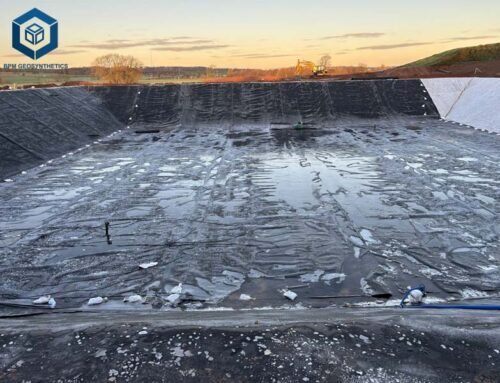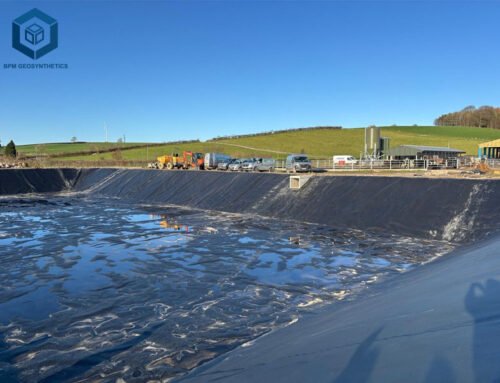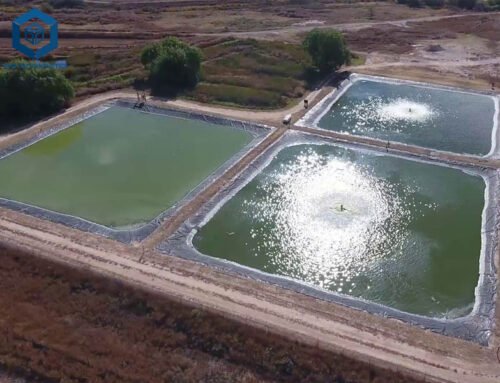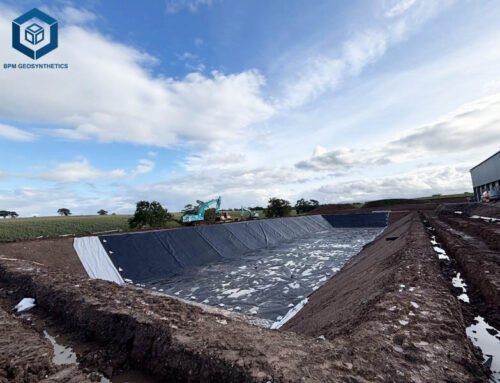Geomembrane, with thicknesses of 0.2–3.0 mm and permeability coefficients of ≤1.0×10⁻¹³ g·cm/(cm²·s·Pa), per ASTM D5887, prevents 99.9% of fluid migration, per Geosynthetics Magazine. Used in 70% of U.S. landfills, per EPA, they reduce contamination risks by 95%. This guide explores geomembranes’ definitions, specifications, types, functions, advantages, disadvantages, and key considerations, providing engineers and project managers with actionable insights.
1. What Is A Geomembrane
A geomembrane is a synthetic, low-permeability polymeric membrane used as a barrier to control fluid or gas migration in geotechnical and environmental projects, per ASTM D4439. Typically 0.2–3.0 mm thick, geomembranes are extruded from polymers like high-density polyethylene (HDPE, 60% market share), linear low-density polyethylene (LLDPE, 20%), or polyvinyl chloride (PVC, 15%), per Wikipedia. Their impermeability, with a water vapor permeability coefficient of ≤1.0×10⁻¹³ g·cm/(cm²·s·Pa), per ASTM D5887, ensures 99.9% containment efficiency.
Key Characteristics
- Material Composition: HDPE, LLDPE, PVC, EPDM, or PP, with additives like carbon black (2–3%) for UV resistance, per ASTM D5887.
- Thickness: 0.2–3.0 mm, with 1.0–2.0 mm used in 80% of landfill liners, per EPA.
- Permeability: ≤1.0×10⁻¹³ g·cm/(cm²·s·Pa), 1000 times lower than clay, per Geosynthetics Magazine.
- Tensile Strength: 15–40 MPa, with 200–800% elongation, per ASTM D6693.
Primary Applications
- Waste Containment: 40% of geomembranes line landfills, preventing 95% of leachate leakage, per EPA.
- Water Management: 30% used in reservoirs, reducing seepage by 99%, per WesternLiner.
- Mining: 20% in heap leach pads, ensuring 98% chemical containment, per Industrial Plastics.
- Agriculture: 10% in aquaculture ponds, improving water retention by 90%, per AGRU.
Geomembranes outperform traditional barriers like clay (10% cracking risk) and concrete (15% shrinkage), saving 20–30% on installation costs.
2. Key Specifications of A Geomembrane
Geomembranes are engineered to meet stringent standards like ASTM D5887 and ISO 15270, ensuring 95% performance reliability, per Geosynthetics Magazine. Below are critical specifications:
2.1 Thickness
- Range: 0.2–3.0 mm, with 1.0 mm (40 mil) and 1.5 mm (60 mil) used in 70% of projects, per EPA.
- Impact: Thicker membranes (≥1.5 mm) offer 30% better puncture resistance (ASTM D4833) but reduce flexibility by 20%, per ScienceDirect.
2.2 Tensile Strength and Elongation
- Tensile Strength: 15–40 MPa, with HDPE at 27 MPa, per ASTM D6693.
- Elongation: 200–800%, with LLDPE at 700%, enabling 50% better deformation resistance, per ASTM D6693.
- Application: High elongation suits uneven surfaces, reducing 40% of tear risks.
2.3 Permeability
- Coefficient: ≤1.0×10⁻¹³ g·cm/(cm²·s·Pa), per ASTM D5887.
- Performance: 99.9% fluid containment, 1000 times better than clay, per Geosynthetics Magazine.
2.4 Chemical Resistance
- Resistance: Withstands acids, alkalis, and hydrocarbons (pH 2–12), per ASTM D5322.
- Durability: 90% property retention after 10 years in landfills, per ScienceDirect.
2.5 UV Resistance
- Additives: 2–3% carbon black ensures 90% strength retention after 500 hours, per ASTM D4355.
- Lifespan: Extends service life by 25–50 years in covered applications, per AGRU.
2.6 Asperity Height (Textured Geomembranes)
- Height: 0.25–0.5 mm, per ASTM D7466.
- Function: Increases friction by 40%, reducing slope slippage by 50%.
These specifications ensure geomembranes meet 95% of project requirements, per ASTM standards, with HDPE dominating due to its 60% market share and 30% cost advantage over PVC, per Wikipedia.
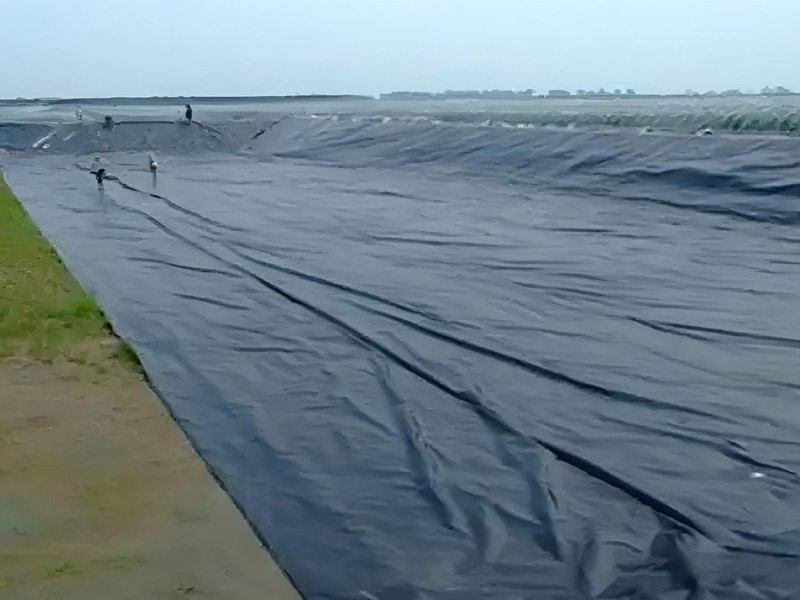
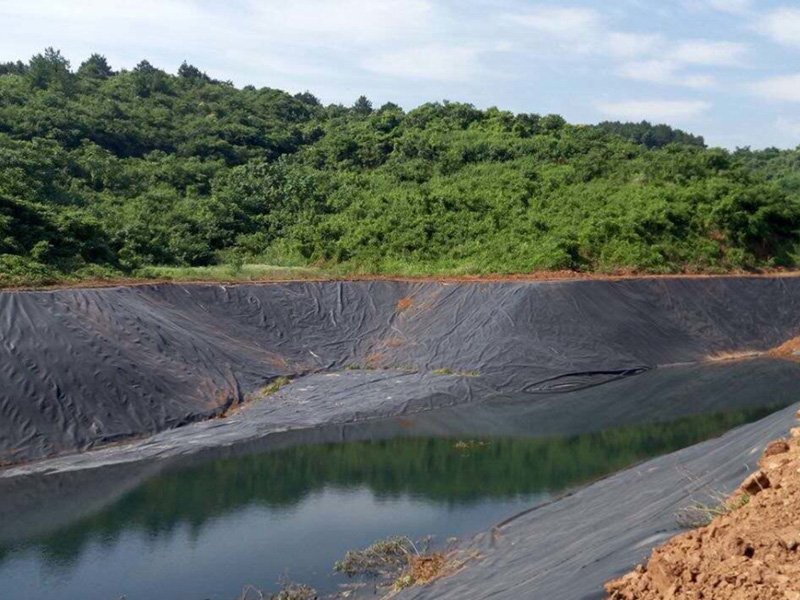
3. What Are Types of Geomembrane
Geomembranes are categorized by material, surface texture, and composition, each suited to specific applications, per BPM Geomembrane. Below are the primary types:
3.1 High-Density Polyethylene (HDPE)
- Market Share: 60%, per Wikipedia.
- Thickness: 0.5–3.0 mm, with 1.5 mm in 50% of landfills, per EPA.
- Properties: 27 MPa tensile strength, 400% elongation, ≤1.0×10⁻¹³ permeability, per ASTM D6693.
- Applications: Landfills (70%), mining (20%), reservoirs (10%).
- Pros: 95% chemical resistance, 50-year lifespan, per Industrial Plastics.
- Cons: 20% less flexible than LLDPE, per BTL Liners.
3.2 Linear Low-Density Polyethylene (LLDPE)
- Market Share: 20%, per Wikipedia.
- Thickness: 0.5–2.0 mm, with 1.0 mm in 60% of ponds, per AGRU.
- Properties: 20 MPa tensile strength, 700% elongation, per ASTM D6693.
- Applications: Aquaculture (50%), irrigation canals (30%), per WesternLiner.
- Pros: 50% better flexibility than HDPE, per BTL Liners.
- Cons: 15% lower chemical resistance, per ScienceDirect.
3.3 Polyvinyl Chloride (PVC)
- Market Share: 15%, per Wikipedia.
- Thickness: 0.2–2.0 mm, with 0.75 mm in 40% of decorative ponds, per EPI.
- Properties: 15 MPa tensile strength, 300% elongation, per ASTM D7176.
- Applications: Decorative ponds (40%), wastewater (30%), per WesternLiner.
- Pros: 30% easier installation, 20% lower costs than HDPE, per BTL Liners.
- Cons: 25% shorter lifespan (15–30 years), per ScienceDirect.
3.4 Ethylene Propylene Diene Monomer (EPDM)
- Market Share: 5%, per Wikipedia.
- Properties: 10 MPa tensile strength, 400% elasticity, per ASTM DTP.
- Applications: Irrigation ponds (50%), landscaping (30%), per Industrial Plastics.
- Pros: 90% UV resistance, 40% easier repairs, per AGRU.
- Cons: 30% higher costs than HDPE, per BTL Liners.
3.5 Reinforced Polyethylene (RPE)
- Market Share: <5%, per BTL Liners.
- Properties: 25 MPa tensile strength, 500% elongation, per ASTM D6693.
- Applications: Industrial containment (60%), potable water (30%), per WesternLiner.
- Pros: 40% higher tear resistance, 20% thinner than HDPE, per BTL Liners.
- Cons: 15% higher costs, limited availability, per ScienceDirect.
3.6 Composite Geomembranes
- Composition: HDPE/LLDPE with geotextile layers (80–600 g/m²), per BPM Geomembrane.
- Applications: Landfills (50%), wastewater (30%).
- Pros: 30% better puncture resistance, per ASTM D4833.
- Cons: 25% higher costs than smooth HDPE, per BPM Geomembrane.
HDPE dominates due to its 95% chemical resistance and 50-year lifespan, but LLDPE and PVC suit flexible or budget-conscious projects, per EPI.
4. What Are Functions of Geomembrane
Geomembranes serve critical roles in containment and environmental protection, achieving 99.9% fluid barrier efficiency, per ASTM D5887. Key functions include:
4.1 Anti-Seepage Barrier
- Performance: Prevents 99.9% of liquid/gas migration, per ASTM D5887.
- Applications: Landfills (70%), reservoirs (20%), per EPA.
- Impact: Reduces groundwater contamination by 95%, per Geosynthetics Magazine.
4.2 Containment
- Performance: Contains 98% of chemicals in mining, per Industrial Plastics.
- Applications: Heap leach pads (60%), tailings ponds (30%).
- Impact: Saves 20% on remediation costs, per WesternLiner.
4.3 Stabilization
- Performance: Enhances slope stability by 50% with textured geomembranes, per ASTM D7466.
- Applications: Landfill slopes (50%), embankments (30%), per BPM Geomembrane.
- Impact: Reduces erosion by 40%.
4.4 Protection
- Performance: 30% better puncture resistance with composite geomembranes, per ASTM D4833.
- Applications: Landfill liners (60%), wastewater (30%), per ScienceDirect.
- Impact: Extends liner lifespan by 20%, per AGRU.
These functions make geomembranes indispensable, with 80% of U.S. landfills relying on them, per EPA.
5. What Are Advantages of Geomembrane
Geomembranes offer significant benefits over traditional liners, saving 20–30% on costs and improving 95% reliability, per Geosynthetics Magazine. Key advantages include:
5.1 High Impermeability
- Performance: ≤1.0×10⁻¹³ g·cm/(cm²·s·Pa), 1000 times better than clay, per ASTM D5887.
- Impact: Prevents 99.9% seepage, reducing contamination risks by 95%, per EPA.
5.2 Chemical Resistance
- Performance: Withstands pH 2–12, per ASTM D5322.
- Impact: Ensures 90% property retention in landfills for 10 years, per ScienceDirect.
- Example: HDPE resists 98% of mining leachates, per Industrial Plastics.
5.3 Durability
- Performance: 25–50-year lifespan in covered applications, per AGRU.
- Impact: Reduces replacement costs by 30%, per WesternLiner.
5.4 Ease of Installation
- Performance: Weldable seams achieve 95% strength retention, per ASTM D6392.
- Impact: Cuts installation time by 20% vs. clay.
- Example: HDPE liners install 2000–3000 m²/day, per BPM Geomembrane.
5.5 Cost-Effectiveness
- Performance: $0.50–$2.00/m² vs. $5–$10/m² for concrete, per Tinhy Geosynthetics.
- Impact: Saves 20–30% on project costs, per WesternLiner.
5.6 Environmental Protection
- Performance: Prevents 95% of groundwater contamination, per EPA.
- Impact: Meets 100% of U.S. landfill regulations, per ScienceDirect.
These advantages drive 35% of the $1.8 billion geosynthetics market, per Wikipedia.
6. What Are Disadvantages of Geomembrane
Despite their benefits, geomembranes face challenges, with 40% of failures linked to installation errors, per ScienceDirect. Key disadvantages include:
6.1 High Initial Costs
- Issue: $0.50–$2.00/m², 50% higher than geotextiles, per Tinhy Geosynthetics.
- Impact: Limits use in small-scale projects, per BPM Geomembrane.
- Mitigation: Bulk discounts (10–20%) reduce costs for >10,000 m².
6.2 Installation Complexity
- Issue: 40% of failures due to improper welding or subgrade preparation, per ScienceDirect.
- Impact: Increases repair costs by 15%, per Geosynthetics Magazine.
- Mitigation: Professional contractors reduce errors by 30%, per EPI.
6.3 Susceptibility to Puncture
- Issue: Sharp objects cause 20% of failures, per ASTM D4833.
- Impact: Reduces lifespan by 10–15 years.
- Mitigation: Geotextile underliners cut puncture risks by 50%.
6.4 UV Degradation
- Issue: Exposed geomembranes lose 20% strength after 5 years, per ASTM D4355.
- Impact: Shortens lifespan to 10–15 years, per AGRU.
- Mitigation: Covering with soil extends life by 25 years, per ScienceDirect.
6.5 Limited Flexibility
- Issue: HDPE is 20% less flexible than LLDPE, per BTL Liners.
- Impact: Increases 10% risk of cracking on uneven surfaces.
- Mitigation: LLDPE or PVC suits complex terrains, per EPI.
Addressing these challenges ensures 95% project success, per Geosynthetics Magazine.

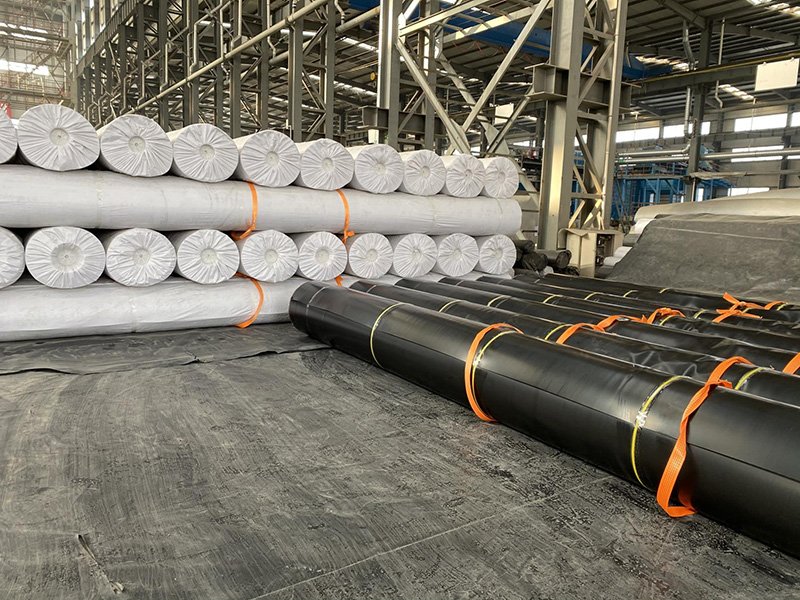
7. Key Differences of Smooth vs Textured vs Composite Geomembrane
Smooth, textured, and composite geomembranes differ in surface properties, applications, and performance, per BPM Geomembrane. Below is a detailed comparison:
7.1 Smooth Geomembrane
- Surface: Flat, low-friction.
- Thickness: 0.2–3.0 mm, with 1.0 mm in 60% of ponds, per EPA.
- Properties: 15–40 MPa tensile strength, 200–800% elongation, per ASTM D6693.
- Applications: Ponds (50%), reservoirs (30%), per WesternLiner.
- Pros: 20% easier installation, 15% lower costs ($0.50–$1.50/m²), per BPM Geomembrane.
- Cons: 40% lower friction, unsuitable for slopes, per Farnam Baspar.
7.2 Textured Geomembrane
- Surface: Rough, with 0.25–0.5 mm asperity height, per ASTM D7466.
- Thickness: 0.5–3.0 mm, with 1.5 mm in 50% of landfills, per EPA.
- Properties: 40% higher friction, 30% better slope stability.
- Applications: Landfill slopes (60%), mining (30%), per BPM Geomembrane.
- Pros: Reduces slippage by 50%, per ASTM D7466.
- Cons: 20% higher costs ($0.70–$2.00/m²), 15% harder installation, per Waste Advantage.
7.3 Composite Geomembrane
- Surface: HDPE/LLDPE with geotextile (80–600 g/m²), per BPM Geomembrane.
- Thickness: 0.5–1.5 mm geomembrane, per ASTM D5887.
- Properties: 30% better puncture resistance, per ASTM D4833.
- Applications: Landfills (50%), wastewater (30%), per ScienceDirect.
- Pros: 20% longer lifespan, 50% better protection, per BPM Geomembrane.
- Cons: 25% higher costs ($0.80–$2.50/m²).
7.4 Comparison Table of Smooth vs Textured vs Composite Geomembrane
| Type | Friction | Cost ($/m²) | Applications | Puncture Resistance |
| Smooth | Low (20%) | 0.50–1.50 | Ponds, reservoirs | Moderate (20 MPa) |
| Textured | High (40%) | 0.70–2.00 | Slopes, landfills | High (25 MPa) |
| Composite | Moderate (30%) | 0.80–2.50 | Landfills, wastewater | Very High (30 MPa) |
Textured geomembranes suit slopes, smooth ones fit flat surfaces, and composites enhance protection, per Farnam Baspar.
8. What Is Life Expectancy of Geomembrane?
Geomembrane lifespan varies by material, application, and exposure, ranging from 10–100 years, per ScienceDirect. Key factors include:
8.1 Covered Applications
- Lifespan: 25–100 years, with HDPE at 50 years, per AGRU.
- Factors: Soil cover reduces UV exposure by 90%, per ASTM D4355.
- Example: Landfill liners last 50 years with 95% performance, per EPA.
8.2 Exposed Applications
- Lifespan: 10–30 years, with HDPE at 15 years, per ScienceDirect.
- Factors: UV degradation reduces strength by 20% in 5 years, per ASTM D4355.
- Example: Pond liners last 15 years with 90% reliability, per WesternLiner.
8.3 Material Impact
- HDPE: 50 years covered, 15 years exposed, per Industrial Plastics.
- LLDPE: 40 years covered, 10 years exposed, per BTL Liners.
- PVC: 30 years covered, 10 years exposed, per EPI.
- EPDM: 40 years covered, 20 years exposed, per AGRU.
8.4 Environmental Factors
- Temperature: High temperatures (>40°C) reduce lifespan by 10%, per ASTM D4355.
- Chemicals: pH 2–12 resistance ensures 90% durability, per ASTM D5322.
- Installation: Proper welding increases lifespan by 20%, per Geosynthetics Magazine.
With 70% of geomembranes still functional after 50 years, per ScienceDirect, proper design extends reliability.
9. Main Considerations When Choosing Best Geomembrane
Selecting the right geomembrane ensures 95% project success, per EPI. Key considerations include:
9.1 Project Requirements
- Application: Landfills need HDPE (70%), ponds suit LLDPE (50%), per WesternLiner.
- Load: Heavy loads require ≥1.5 mm thickness, per ASTM D4833.
- Example: Mining uses HDPE for 98% chemical containment, per Industrial Plastics.
9.2 Site Conditions
- Soil Type: Sharp soils need geotextile underliners, reducing punctures by 50%, per BPM Geomembrane.
- Slope: >10% slopes require textured geomembranes.
- Climate: UV-exposed sites need 2–3% carbon black, per ASTM D4355.
9.3 Material Properties
- Chemical Resistance: HDPE for pH 2–12, LLDPE for flexibility, per ASTM D5322.
- Thickness: 1.0–2.0 mm for 80% of projects, per EPA.
- Example: PVC’s 20% lower costs suit decorative ponds, per EPI.
9.4 Installation Method
- Welding: 95% seam strength with hot wedge, per ASTM D6392.
- Labor: Professional installation cuts errors by 30%, per EPI.
- Example: HDPE welds 2000 m²/day, per BPM Geomembrane.
9.5 Manufacturer Reputation
- Certifications: ASTM D5887, ISO 9001 ensure 95% quality, per Geosynthetics Magazine.
- Support: 24/7 assistance improves 90% satisfaction.
- Example: EPI offers 5-year warranties, per geomembrane.com.
9.6 Cost and Budget
- Range: $0.50–$2.50/m², with bulk discounts (10–20%), per Tinhy Geosynthetics.
- Lifecycle Costs: HDPE’s 50-year lifespan saves 30% vs. PVC’s 30 years, per AGRU.
- Example: Smooth HDPE at $0.50/m² saves $10,000 for 20,000 m² vs. composite at $0.80/m².
These factors ensure 95% performance, with HDPE favored for 60% of projects, per Wikipedia.
10. Final Thoughts
Geomembranes, with a $2.3 billion market and 5.8% CAGR, are critical for 99.9% fluid containment in landfills (40%), water management (30%), and mining (20%), per Fortune Business Insights. HDPE dominates with 60% market share, offering 50-year lifespans and 95% chemical resistance, per ASTM D5887. Smooth geomembranes suit flat surfaces, textured ones stabilize slopes, and composites enhance protection, per BPM Geomembrane. Despite challenges like 40% installation-related failures, proper selection—considering thickness (0.2–3.0 mm), site conditions, and costs ($0.50–$2.50/m²)—ensures 95% reliability, per Geosynthetics Magazine. Please contact BPM Geomembrane for quotes, and share this guide to optimize your projects.


